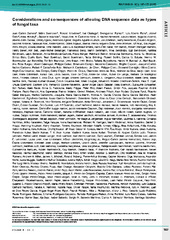Considerations and consequences of allowing DNA sequence data as types of fungal taxa
| dc.contributor.author | Zamora, Juan Carlos | |
| dc.contributor.author | Svensson, Måns | |
| dc.contributor.author | Kirschner, Roland | |
| dc.contributor.author | Olariaga, Ibai | |
| dc.contributor.author | Ryman, Svengunnar | |
| dc.contributor.author | Parra, Luis Alberto | |
| dc.contributor.author | Geml, József | |
| dc.contributor.author | Rosling, Anna | |
| dc.contributor.author | Adamčík, Slavomír | |
| dc.contributor.author | Ahti, Teuvo | |
| dc.contributor.author | Aime, M. Catherine | |
| dc.contributor.author | Ainsworth, Martyn | |
| dc.contributor.author | Albert, László | |
| dc.contributor.author | Alberto, Altés Garcia | |
| dc.contributor.author | Albertó, Edgardo | |
| dc.contributor.author | Aronsen, Arne | |
| dc.contributor.author | Arup, Ulf | |
| dc.contributor.author | Asgari, Didier | |
| dc.contributor.author | Assyov, Boris | |
| dc.contributor.author | Atienza, Violeta | |
| dc.contributor.author | Bandini, Ditte | |
| dc.contributor.author | Baptista-Ferreira, João Luís | |
| dc.contributor.author | Baral, Hans-Otto | |
| dc.contributor.author | Bendiksby, Mika | |
| dc.contributor.author | Bendiksen, Egil | |
| dc.contributor.author | Bendiksen, Katriina | |
| dc.contributor.author | Brandrud, Tor Erik | |
| dc.contributor.author | Frisch, Andreas | |
| dc.contributor.author | Gulden, Gro | |
| dc.contributor.author | Høiland, Klaus | |
| dc.contributor.author | Holien, Håkon | |
| dc.contributor.author | Jørgensen, Per Magnus | |
| dc.contributor.author | Larsson, Karl-Henrik | |
| dc.contributor.author | Mathiassen, Geir Harald | |
| dc.contributor.author | Ronikier, Anna | |
| dc.contributor.author | Salcedo, Isabel | |
| dc.contributor.author | Schulz, Barbara | |
| dc.contributor.author | Schumacher, Trond | |
| dc.contributor.author | Senn-Irlet, Beatrice | |
| dc.contributor.author | Spribille, Toby | |
| dc.contributor.author | Taskin, Hatira | |
| dc.contributor.author | Timdal, Einar | |
| dc.contributor.author | Tønsberg, Tor | |
| dc.contributor.author | Vellinga, Else C | |
| dc.contributor.author | Vizzini, Alfredo | |
| dc.contributor.author | Vetlesen, Per | |
| dc.contributor.author | Voglmayr, Hermann | |
| dc.contributor.author | Wedin, Mats | |
| dc.contributor.author | Weholt, Øyvind | |
| dc.contributor.author | Westberg, Martin | |
| dc.date.accessioned | 2019-05-22T09:20:45Z | |
| dc.date.available | 2019-05-22T09:20:45Z | |
| dc.date.issued | 2018-06 | |
| dc.Published | Zamora, Svensson M, Kirschner, Olariaga I, Ryman, Parra, Geml J, Rosling A, Adamčík S, Ahti T, Aime, Ainsworth M, Albert, Alberto, Albertó, Aronsen A, Arup U, Asgari, Assyov, Atienza, Bandini, Baptista-Ferreira, Baral H, Bendiksby M, Bendiksen E, Bendiksen K, Brandrud TE, Frisch A, Gulden G, Høiland K, Holien H, Jørgensen PM, Larsson K-H, Mathiassen GH, Ronikier, Salcedo I, Schulz, Schumacher T, Senn-Irlet B, Spribille T, Taskin, Timdal E, Tønsberg T, Vellinga EC, Vizzini A, Vetlesen, Voglmayr H, Wedin M, Weholt Ø, Westberg M. Considerations and consequences of allowing DNA sequence data as types of fungal taxa. IMA Fungus. 2018;9(1):167-175 | eng |
| dc.identifier.issn | 2210-6340 | |
| dc.identifier.issn | 2210-6359 | |
| dc.identifier.uri | https://hdl.handle.net/1956/19684 | |
| dc.description.abstract | Nomenclatural type definitions are one of the most important concepts in biological nomenclature. Being physical objects that can be re-studied by other researchers, types permanently link taxonomy (an artificial agreement to classify biological diversity) with nomenclature (an artificial agreement to name biological diversity). Two proposals to amend the International Code of Nomenclature for algae, fungi, and plants (ICN), allowing DNA sequences alone (of any region and extent) to serve as types of taxon names for voucherless fungi (mainly putative taxa from environmental DNA sequences), have been submitted to be voted on at the 11th International Mycological Congress (Puerto Rico, July 2018). We consider various genetic processes affecting the distribution of alleles among taxa and find that alleles may not consistently and uniquely represent the species within which they are contained. Should the proposals be accepted, the meaning of nomenclatural types would change in a fundamental way from physical objects as sources of data to the data themselves. Such changes are conducive to irreproducible science, the potential typification on artefactual data, and massive creation of names with low information content, ultimately causing nomenclatural instability and unnecessary work for future researchers that would stall future explorations of fungal diversity. We conclude that the acceptance of DNA sequences alone as types of names of taxa, under the terms used in the current proposals, is unnecessary and would not solve the problem of naming putative taxa known only from DNA sequences in a scientifically defensible way. As an alternative, we highlight the use of formulas for naming putative taxa (candidate taxa) that do not require any modification of the ICN. | en_US |
| dc.language.iso | eng | eng |
| dc.publisher | The International Mycological Association | eng |
| dc.rights | Attribution CC BY-NC-ND | eng |
| dc.rights.uri | http://creativecommons.org/licenses/by-nc-nd/3.0/ | eng |
| dc.subject | IMC11 | eng |
| dc.subject | nomenclature | eng |
| dc.subject | speciation | eng |
| dc.subject | taxonomy | eng |
| dc.subject | typification | eng |
| dc.subject | voucherless fungi | eng |
| dc.title | Considerations and consequences of allowing DNA sequence data as types of fungal taxa | eng |
| dc.type | Peer reviewed | en_US |
| dc.type | Journal article | en_US |
| dc.date.updated | 2019-02-14T14:54:19Z | |
| dc.description.version | publishedVersion | |
| dc.rights.holder | Copyright 2018 International Mycological Association | eng |
| dc.identifier.doi | https://doi.org/10.5598/imafungus.2018.09.01.10 | |
| dc.identifier.cristin | 1612391 | |
| dc.source.journal | IMA Fungus |

